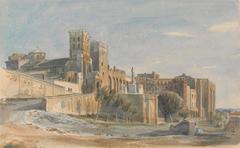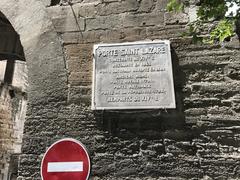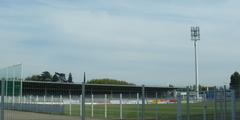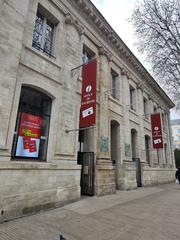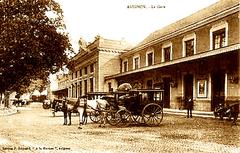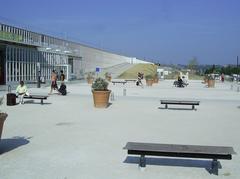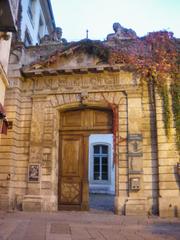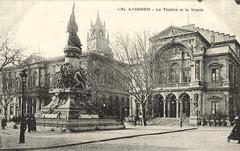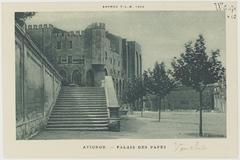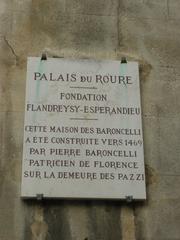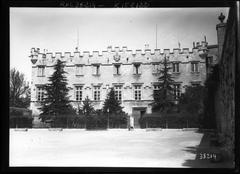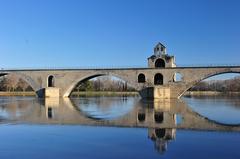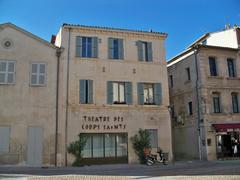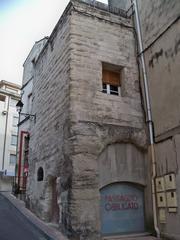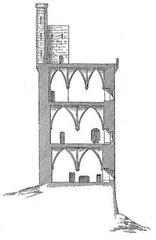
Double Viaduc TGV d’Avignon: Visiting Hours, Tickets, and Travel Guide
Date: 04/07/2025
Introduction
The Double Viaduc TGV d’Avignon is a landmark of modern engineering and architectural finesse, seamlessly integrated into Avignon’s historic and natural landscape. Spanning around 1,500 meters across the Rhône River, this pair of parallel viaducts is a vital segment of the LGV Méditerranée high-speed rail line. Designed for trains traveling at speeds up to 350 km/h, the viaducts connect cities such as Paris, Marseille, Montpellier, and Nîmes, playing a critical role in France’s transport infrastructure. Conceived in the late 20th century, the project overcame significant technical and environmental challenges, resulting in a structure that harmonizes with Avignon’s UNESCO World Heritage context. Today, visitors can admire the viaducts from multiple vantage points while exploring Avignon’s medieval heritage. This comprehensive guide offers detailed insights into the viaduct’s history, design, technical features, visitor information, and travel tips for a rewarding visit. (Bouygues TP, maregionsud.fr, Wikipedia, Official Avignon Tourism Website)
Table of Contents
- Introduction
- Historical Context
- Planning, Design, and Construction
- Technical Specifications
- Visitor Information
- Accessibility and Travel Tips
- Nearby Attractions
- FAQs
- Additional Resources & References
Historical Context
The Need for High-Speed Rail Across the Rhône
France’s expansion of its high-speed rail network in the late 20th century necessitated a solution for crossing the Rhône River near Avignon. The LGV Méditerranée was developed to connect Paris with the Mediterranean, requiring a crossing that would allow uninterrupted high-speed travel while respecting the region’s environmental and historical significance. The Rhône posed both technical and environmental challenges, which were addressed through innovative engineering and thoughtful planning (Wikipedia; maregionsud.fr).
Planning, Design, and Construction
Design Philosophy
A multidisciplinary team led by architect Jean-François Blassel, landscape architect Michel Desvignes, and engineer Michel Virlogeux sought to harmonize the viaducts with the landscape. The design uses pale, prestressed concrete, echoing the limestone of the Angles massif and the white walls of the Palais des Papes, while minimizing visual intrusion on Avignon’s historic skyline (Bouygues TP; micheldesvignepaysagiste.com).
Construction Timeline
- Start: April 1996
- Completion: 1999
- Official Opening: June 7, 2001
The project, managed by Réseau Ferré de France (RFF) and constructed by Bouygues Construction and GTM Construction, employed up to 500 workers and introduced several technical innovations:
- Segmental Construction: 838 prefabricated concrete segments (“voussoirs”), each weighing 110–145 tonnes, assembled using the balanced cantilever method.
- Variable Geometry: The height of segments decreases from piers to the center, creating a slender profile and reducing material usage.
- White Cement Concrete: Chosen for durability and aesthetic integration with the local landscape (Bouygues TP; maregionsud.fr).
Technical Specifications
- Length: Approximately 1,500 meters
- Structure: Two parallel bridges, each with two tracks
- Viaduc TGV: Paris–Marseille route
- Viaduc Grand Sud: Marseille–Montpellier/Nîmes route
- Spans: 100 meters each, with approach structures of 392 and 450 meters
- Piers: 40, rising up to 50 meters above the river
- Deck Area: 39,000 square meters
- Special Features: “Saut-de-mouton” (grade-separated crossing) for efficient rail junctions
- Materials: Prestressed, white cement concrete for resilience and visual harmony (Wikipedia; Bouygues TP)
Visitor Information
Viewing the Viaduct
The viaducts are active railway bridges and not open to pedestrian or cycling traffic. However, several public vantage points offer spectacular views:
- Rocher des Doms: Panoramic views over the Rhône and viaduct.
- Île de la Barthelasse: Riverbank trails and picnic spots with clear sightlines.
- Riverbanks and Walking Paths: Accessible year-round from dawn to dusk.
No tickets are required to access these public areas. For a unique experience, book a TGV journey that crosses the viaduct (SNCF Official Site).
Accessibility
- Wheelchair Access: Main viewing areas such as Rocher des Doms and riverbanks are wheelchair accessible.
- Transport: The Avignon TGV station is connected via local buses, taxis, and rental cars. Train and bus schedules should be checked in advance (Marvellous Provence).
Accessibility and Travel Tips
- Getting There: Avignon TGV station is served by high-speed trains from Paris, Marseille, and Lyon. Local buses (lines 10, 21) and regional TER trains connect the station to the city center (Show Me The Journey).
- Parking: Several parking lots, including a 15-minute “kiss-and-ride” area, are available at the TGV station. During peak periods, overflow parking may be limited.
- Station Facilities: The station offers a newsagent, cafeteria, payphones, and free Wi-Fi, but lacks left-luggage facilities.
- Best Times to Visit: Early morning and late afternoon provide optimal lighting for photography.
Nearby Attractions
Avignon is renowned for its medieval heritage, offering a wealth of cultural experiences:
- Palais des Papes: The largest Gothic palace in Europe and a UNESCO World Heritage site.
- Pont Saint-Bénézet (Pont d’Avignon): The iconic medieval bridge.
- Place de l’Horloge: A lively square with cafés and markets.
- Île de la Barthelasse: Ideal for walking and cycling, with views of both the city and viaduct.
Combine your viaduct visit with these attractions for a well-rounded Avignon experience. (The Crazy Tourist; The Travel Folk)
Frequently Asked Questions (FAQs)
Can I walk or cycle across the Double Viaduc TGV d’Avignon?
No, the viaducts are reserved for rail traffic only.
Are there guided tours focused on the viaduct?
While there is no dedicated visitor center or regular guided tours, some local tour operators include the viaduct in Avignon sightseeing itineraries. Check with the Avignon tourism office for current offerings.
Where are the best places to view the viaduct?
The Rocher des Doms, Île de la Barthelasse, and riverbank trails provide excellent vantage points.
Is the viaduct accessible for people with disabilities?
Yes, many viewing spots and station facilities are accessible.
Do I need tickets to see the viaduct?
No tickets are required to access public viewing areas. You’ll need a train ticket if you wish to cross the viaduct by TGV.
Additional Resources & References
For more information, visit:
- Official Avignon Tourism Website
- Bouygues Construction – Avignon Viaducts
- Michel Desvignes Landscape Architecture
- SNCF Connect Official Website
- Marvellous Provence – Avignon Rail Travel Information
- Show Me The Journey – Avignon TGV Station Info
- Double viaduc TGV d’Avignon - Wikipedia
- Double Viaduc d’Avignon - maregionsud.fr
- The Crazy Tourist – Best Things to Do in Avignon
- The Travel Folk – One Day in Avignon
- Flickr – Viaduc Images
Summary & Final Tips
The Double Viaduc TGV d’Avignon stands as a symbol of France’s commitment to integrating advanced infrastructure within a landscape rich in history and natural beauty. Although not open to public access, the viaduct is easy to admire from multiple public viewpoints. Enhance your visit to Avignon by combining scenic views of this modern marvel with explorations of the city’s world-famous medieval sites. For the latest travel tips, guided tours, and visitor updates, consult local tourism offices and the Audiala app.
Enjoy your journey through Avignon’s fusion of heritage and innovation!


